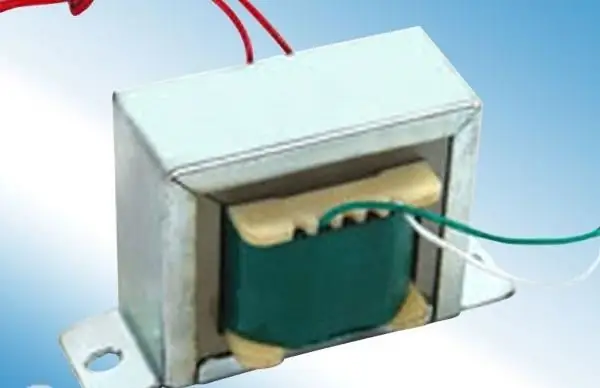2026 Author: Howard Calhoun | [email protected]. Last modified: 2025-01-24 13:10:41
Transformers in the infrastructure of power supply systems can have different meanings. Classical designs are used to convert individual current parameters to values that are optimally suited for measurements. There are other varieties, the list of tasks of which includes the correction of voltage characteristics to a level that is optimal from the point of view of further transmission and distribution of the energy resource. At the same time, the purpose of the current transformer determines not only its structural device, but also the list of additional functions, not to mention the principle of operation.

Transformer device
Almost all modifications of transformers of this type are equipped with magnetic circuits, which are supplied with a secondary winding. The latter is loaded during operation in accordance with the prescribed values in terms of resistance. Compliance with certain load values is important for subsequent measurement accuracy. An open winding cannot create compensation for magnetic fluxes in the core, which contributes to overheating of the magnetic circuit, and in some cases, its combustion.
At the same time magneticthe flux generated by the primary winding has a higher performance, which can also contribute to overheating of the magnetic wire and its core. It must be said that the conductive infrastructure forms a common system on which current and voltage transformers are based. The purpose of the electrical unit in this case is not of fundamental importance - the features of functioning are rather determined by the materials used. In the case of current converters, for example, the core of the magnetic circuit is made of amorphous nanocrystalline alloys. This choice is due to the fact that the design gets the opportunity to work with a wider range of technical and operational values, depending on the accuracy class.

Appointment of the current transformer
The main task of the traditional current transformer is to transform. The hardware electrical filling corrects the characteristics of the current being served, using for this the primary winding connected in series in the circuit. In turn, the secondary winding performs the function of directly measuring the converted current. For this, relays with measuring instruments, as well as protection and automatic control devices are provided in this part. In particular, the purpose of a measuring current transformer may be to measure and account using low voltage devices. At the same time, the condition is observed under which the high voltage current is recorded with personnel access todirect observation of the process. Fixing the operating values is required for a more rational use of energy during transmission in subsequent lines. Perhaps this is one of the few common sub-functions that transforming and power transformer models have. It is worth considering the differences between these units in more detail.
Differences from voltage transformer
Most often, experts point out how to perform insulation between the windings. In current transformers, the primary winding is isolated from the secondary winding in accordance with the indicators of the total received voltage. In this case, the secondary winding will have a ground, therefore, its potential corresponds to a similar indicator. In addition, instrument transformers operate in conditions close to short-circuit situations, since they have a very modest level of resistance on the secondary line. This nuance reveals the specific purpose of measuring current and voltage transformers, as well as the difference in requirements for operating conditions.
So, if operation under the threat of a short circuit for a power voltage transformer is unacceptable due to the risk of an accident, then for a conventional current converter this mode of operation is considered normal and safe. Although, of course, such transformers also have their own threats, to prevent which special means of protection are provided.

Working principle
Electromagnetic induction is the basic principle on which theworking process of such transformers. As already noted, the main functional elements are a magnetic conductor and two levels of windings. The first level is supplied with an electric charge from an alternating current, and the second level implements a directly working function in the form of a measurement. As current flows through the turns of the winding, induction occurs.
Further, according to the law of electromagnetic induction, which just determines the purpose and principle of operation of current transformers, the operating values are fixed on the line. The user, using special equipment, can determine the characteristics of the magnetic flux - therefore, the frequency and voltage of the current source are recorded. The technical parameter of the examination of the characteristics of the circuit will be the speed of the measurement - this value is not a target, but it is important to evaluate it to understand the efficiency of the transformer itself.

Varieties of current transformers
There are three main categories of current converters. The most common are the so-called dry transformers, in which the first level of the winding is not at all isolated from the first. Accordingly, the parameters of the secondary current directly depend on the conversion factor.
Toroidal models are also popular, the design of which provides for the possibility of their installation on a cable or bus. For this reason, the need for a primary winding, which is equipped with typical current and voltage transformers, is completely eliminated. Appointment andthe device of such models is determined by their special principle of operation - in this case, the primary current will flow through the central conductor in the housing, allowing the secondary winding to directly record the performance. But for various reasons, including those associated with low measurement accuracy and unreliable design, such models are rarely used to evaluate current characteristics. More often they are used for the purpose of an auxiliary protective link in case of a short circuit.
High-voltage transformers are also used - gas and oil. They are usually used in specialized projects in industry.
Transformation ratio
To evaluate the efficiency of the transformer itself, the value of the conversion coefficient was introduced. Its nominal value is usually indicated in the official documentation for the transformer. This coefficient indicates the ratio of the primary rated current to that of the second winding. For example, it can be a value of 100/5 A. It can change dramatically depending on the number of sections with turns.
It should also be taken into account that the nominal coefficient does not always correspond to the actual one. The deviation is determined by the conditions in which the current transformers are operated. The purpose and principle of operation are largely determined by the error indicators, but this nuance is not a reason to refuse to take into account the nominal transformation ratio. Knowing the magnitude of the same error, the user can level it using special electrical equipment.

Current transformer installation
The simplest bus models of transformers practically do not require the use of special equipment and even tools. Such a device can be installed by one master using special clamping fittings. Standard designs require the creation of a foundation on which the supporting racks are mounted. Next, a frame is attached by electric welding, which will act as a kind of electrical box for the conclusion of the necessary equipment. At the final stage, the equipment is installed. What will be the set of technical equipment, determines the purpose of the current transformer and the features of its future operation. At a minimum, the infrastructure required to perform serviced circuit measurements is integrated.
Methods of connecting transformers
To facilitate the procedure for connecting wiring to equipment, component manufacturers mark them - for example, current relays and transformers can be designated TAa, TA1, KA1, etc. Thanks to this marking, maintenance personnel will be able to quickly and accurately pair between elements with which the current transformer is equipped. The device, purpose and principle of operation of the installation in this case are closely interconnected and affect the method of connection, but at the same time, the serviced network as such also has a considerable influence on the nature of the technical implementation of the conversion system. For example, three-phase lines with isolated neutral allow the installation of transformers on only twophases. This feature is due to the fact that networks with a range of 6 -35 kV do not have a neutral wire.

Checking transformers
The set of verification measures consists of several operations. First of all, this is a visual inspection of the object, during which the integrity of the structure, the correctness of the same markings, compliance with passport data, etc. are assessed. Then the equipment is demagnetized - for example, by smoothly increasing the current on the first level winding. After that, the current value gradually decreases to zero.
Next, the main verification steps are prepared, which will be subject to measuring current transformers. The purpose and principle of operation is important to take into account in such training, since the level of load and other operational factors cause different values of errors in recording the characteristics of the working environment. The verification itself provides for an assessment of the compliance of the polarity of the winding terminals with the standard parameters, as well as fixing the errors with their subsequent verification with the values \u200b\u200bspecified in the unit's passport.
Safety during transformer operation
The main dangers in the operation of current transformers are related to the quality of the windings. It is important to take into account that a metal base works under the layers of turns, which, in its bare form, can pose a considerable threat to personnel. Therefore, a maintenance schedule is drawn up, according to which the current transformers are checked regularly. Appointment andthe principle of operation in this case can be focused on both voltage conversion and current measurement. In both cases, maintenance personnel must carefully monitor the condition of the windings. As a safety measure, shunt shorts are introduced into the working structure, and the grounding of the winding leads is also maintained.

Conclusion
As the operational loads on the power lines increase, the working life of service stations noticeably decreases. Despite the fact that the purpose of the current transformer is not related to the transformation of high voltage, such equipment is also subject to serious wear and tear. In order to increase the service life of such installations, manufacturers use more technologically advanced materials both for electromagnetic equipment and for making the same winding. At the same time, the equipment for measuring relays is being improved, as a result of which the measurement error coefficient is also minimized.
Recommended:
Bank accounts: current and current account. What is the difference between a checking account and a current account

There are different types of accounts. Some are designed for companies and are not suitable for personal use. Others, on the contrary, are suitable only for shopping. With some knowledge, the type of account can be easily determined by its number. This article will discuss this and other properties of bank accounts
How does an individual entrepreneur withdraw money from a current account? Methods for withdrawing cash from the current account of an individual entrepreneur

Before you register yourself as an individual entrepreneur, you should take into account that withdrawing funds from the current account of an individual entrepreneur is not quite easy, especially at first. There are a number of restrictions, according to which merchants do not have the right to withdraw funds at any time convenient for them and in any amount. How does an individual entrepreneur withdraw money from a current account?
Single-phase transformer. Purpose, device and main characteristics

In practice, many repairers are often faced with the need to replace a burned-out single-phase voltage transformer. To ensure suitability, the characteristics of the replacement device should be examined
Mast transformer substation: principle of operation and purpose

The article is devoted to mast transformer substations. The device, principle of operation, types and purpose of such equipment are considered
What is electric current? Conditions for the existence of electric current: characteristics and actions

Electric current is an electrical charge in motion. It can take the form of a sudden discharge of static electricity, such as lightning. Or it could be a controlled process in generators, batteries, solar or fuel cells. Today we will consider the very concept of "electric current" and the conditions for the existence of electric current

